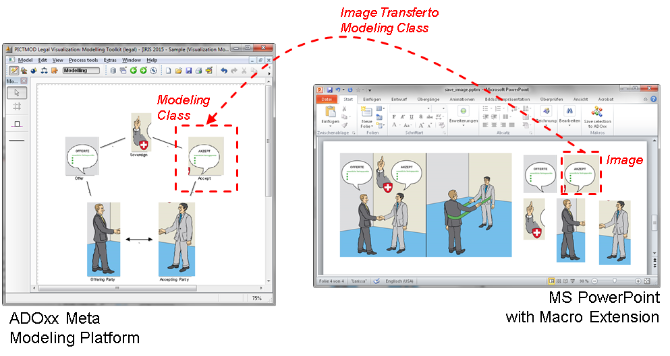1.
Introduction and Motivation ^
2.
Foundations ^
3.
PICTMOD: Bridging Pictorial and Model-based Legal Visualizations ^
Figure 1: Conceptual Architecture for Realizing PICTMOD on a Meta Modeling Platform and a Drawing Tool
4.
Assessment of Feasibility ^
5.
Conclusion ^
6.
References ^
Brunschwig, C. R., Multisensory Law and Legal Informatics – A Comparison of How these Legal Disciplines Relate to Visual Law. In: Geist, A., Brunschwig, C.R., Lachmayer, F. & Schefbeck, G (eds.), Structuring Legal Semantics, Editions Weblaw, Bern, p. 573–668 (2011).
Fill, Hans-Georg, Semantic Interpretations of Legal Visualizations using a Polysyntactic View, in: Geist, A., Brunschwig, C., Lachmayer, F., Schefbeck, G. (eds): Structuring Legal Semantics, Editions Weblaw, Bern, p. 245–256 (2011).
Fill, H.-G., Visualisation for Semantic Information Systems, Gabler (2009).
Fill, H.-G. & Karagiannis, D., On the Conceptualisation of Modelling Methods Using the ADOxx Meta Modelling Platform. Enterprise Modelling and Information Systems Architectures, Vol. 8(1), p. 4–25 (2013).
Fill, H.-G., Redmond, T., Karagiannis, D., FDMM: A Formalism for Describing ADOxx Meta Models and Models. In: Maciaszek, L., Cuzzocrea, A., and Cordeiro, J. (Eds.), ICEIS 2012, Wroclaw, p. 133–144 (2012).
Haapio, H., Making Contracts Work for Clients: towards Greater Clarity and Usability, In: Schweighofer, E. et al. (Eds.), Proceedings of the International Legal Informatics Symposium – Internationales Rechtsinformatik Symposion IRIS 2012, in: Jusletter IT 27 February 2012 (2012).
Kahlig, W., Visualisierungstypologie des Deutschen Privatrechts, in: Jusletter IT 24 February 2011 (2011).
Karagiannis, D., Kühn, H., Metamodelling Platforms, Proceedings of the 3rd International Conference EC-Web 2002 – Dexa 2002 (2002), Full version: http://www.dke.at/fileadmin/DKEHP/publikationen/metamodell/FullVersion_MMP_
DexaECWeb2002.pdf retrieved 10 January 2013.
Hans-Georg Fill, Privatdozent, University of Vienna, Research Group Knowledge Engineering, Währingerstraße 29, 1090 Vienna, AT, hans-georg.fill@univie.ac.at, http://homepage.dke.univie.ac.at/fill








